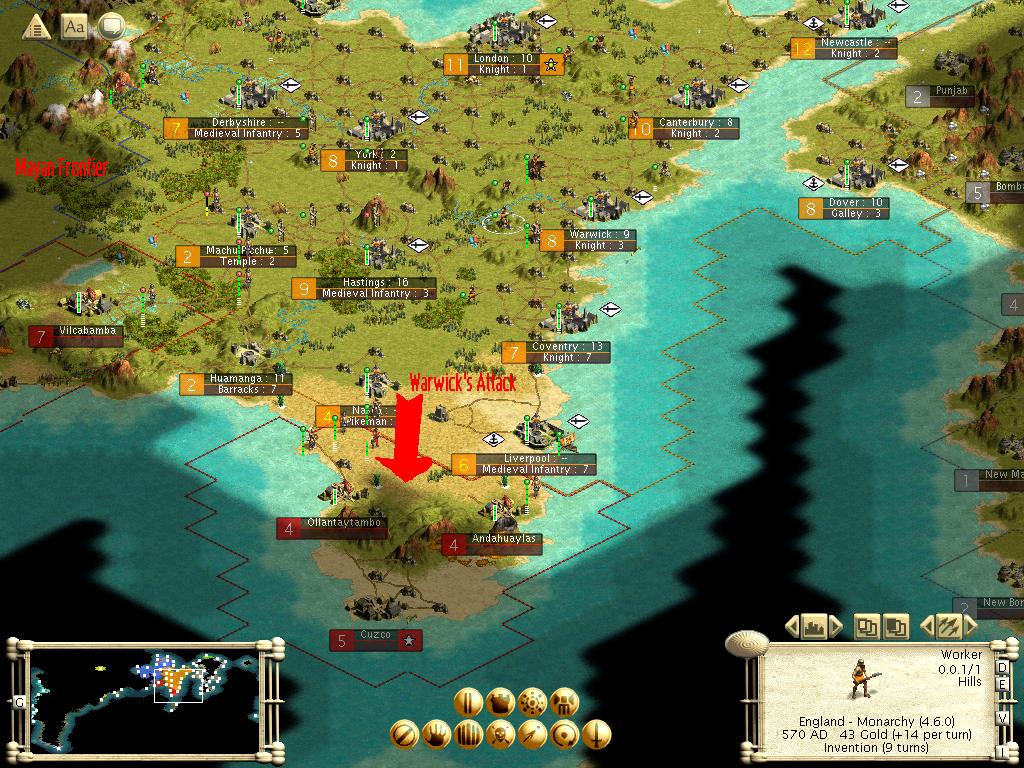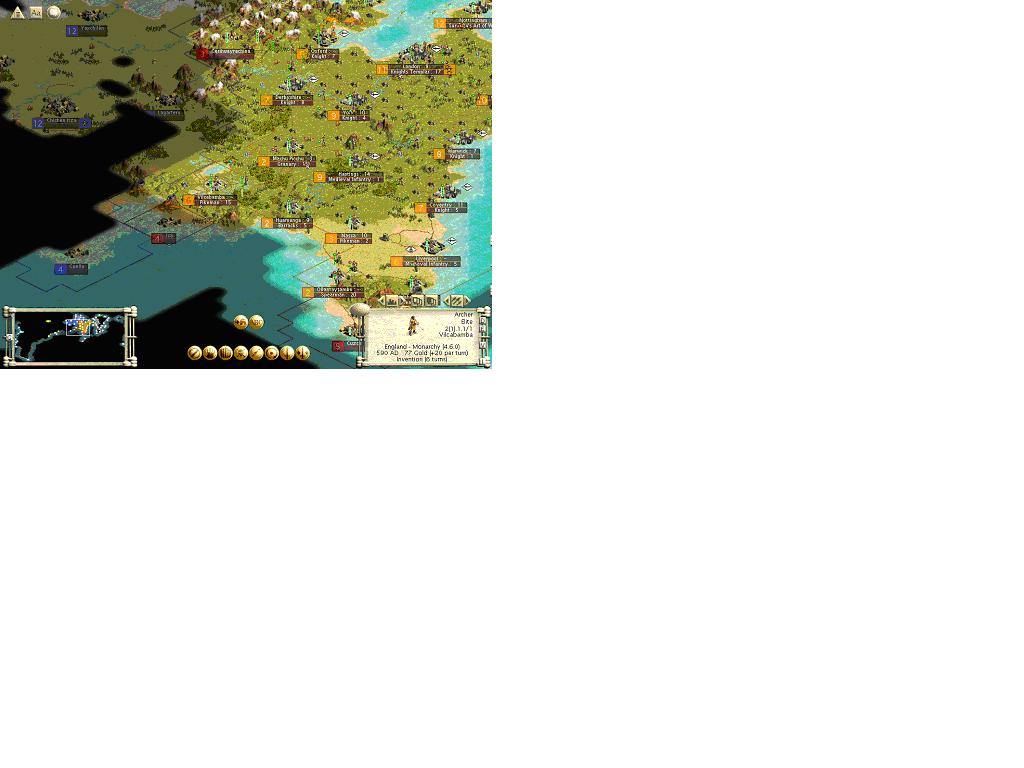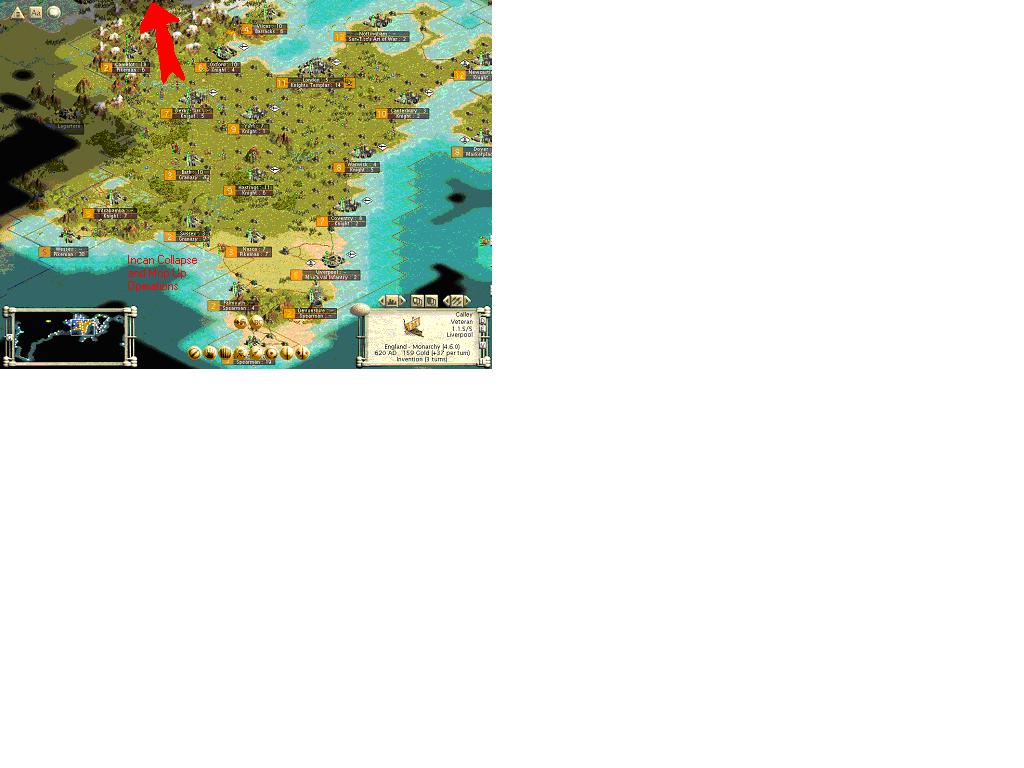spankey
Peachtree Warrior
This is my first posting and first attempt at a story. It is based off the game that I am currently playing with the following stats:
Huge Archipelago
70% water
climate - normal
Temperature - temporate
age- 4 billion
barbs - roaming
The story will be updated using the time scale found in the game. I will get around the immortal aspect of leaders by the use of family dynasties in these roles. I am playing as the English on Regent (C3C) with possibly up to 11 other civilizations. I hope you enjoy....
Ostia had been in the grip of warfare for generations. A relatively large continent, Ostia was the ancestral home of the English, the Incas, and the Mayans. For centuries the three civilizations lived in peace. The English peoples had populated the eastern portion of the continent. The Incans migrated from the Southern desert and occupied the middle swath of the continent. The Mayans originated in the western portion of Ostia and had developed a large, prosperous empire that pressed against the borders of both the English and the Incan empires. The defection of a major Incan city to the English and a border skirmish on the neighboring Eastia continent between the Indian Empire and the Incans drew the English into the war. The war has lasted for fourteen generations and has been harsh on the English peoples and absolutely devastating for the Incans.
The story begins with King Edward I of England in conference with two of his closest military advisors, Lords Ivanhoe and Gwydion.
"Lord Ivanhoe, I do believe that this war is finally turning in our favor".
"Yes, M'Lord. These latest dispatches plainly show that we have split the Incan nation in two. It is time to press toward Cuzco and beat them into submission"
Lord Gwydion, "Sire, I am concerned about the Mayan border. I have heard reports that troop levels are increasing there. Also the Mayan-Zulu war seems to be winding down. The Mayans may soon be free to help the Incans and threaten England herself."
King Edward, " Yes I am worried about that as well. How are the new Knight regiments forming? I have the Duke of Kent and Prince Edward II ready to form two provisional armies of Knights once they are formed."
"Sire, it was very clever of you to elevate the Duke to his current status of Army Leader of no troops to pave the way for your son to form a second provisional army", said Lord Ivanhoe.
"Yes, those two armies will finish this war and will soon even our odds out against the Mayans. It is our destiny to control this continent."
Screen shots to follow. I hope this looks promising...
Huge Archipelago
70% water
climate - normal
Temperature - temporate
age- 4 billion
barbs - roaming
The story will be updated using the time scale found in the game. I will get around the immortal aspect of leaders by the use of family dynasties in these roles. I am playing as the English on Regent (C3C) with possibly up to 11 other civilizations. I hope you enjoy....
Ostia had been in the grip of warfare for generations. A relatively large continent, Ostia was the ancestral home of the English, the Incas, and the Mayans. For centuries the three civilizations lived in peace. The English peoples had populated the eastern portion of the continent. The Incans migrated from the Southern desert and occupied the middle swath of the continent. The Mayans originated in the western portion of Ostia and had developed a large, prosperous empire that pressed against the borders of both the English and the Incan empires. The defection of a major Incan city to the English and a border skirmish on the neighboring Eastia continent between the Indian Empire and the Incans drew the English into the war. The war has lasted for fourteen generations and has been harsh on the English peoples and absolutely devastating for the Incans.
The story begins with King Edward I of England in conference with two of his closest military advisors, Lords Ivanhoe and Gwydion.
"Lord Ivanhoe, I do believe that this war is finally turning in our favor".
"Yes, M'Lord. These latest dispatches plainly show that we have split the Incan nation in two. It is time to press toward Cuzco and beat them into submission"
Lord Gwydion, "Sire, I am concerned about the Mayan border. I have heard reports that troop levels are increasing there. Also the Mayan-Zulu war seems to be winding down. The Mayans may soon be free to help the Incans and threaten England herself."
King Edward, " Yes I am worried about that as well. How are the new Knight regiments forming? I have the Duke of Kent and Prince Edward II ready to form two provisional armies of Knights once they are formed."
"Sire, it was very clever of you to elevate the Duke to his current status of Army Leader of no troops to pave the way for your son to form a second provisional army", said Lord Ivanhoe.
"Yes, those two armies will finish this war and will soon even our odds out against the Mayans. It is our destiny to control this continent."
Screen shots to follow. I hope this looks promising...









 You are not trying world conquest, aren't you?
You are not trying world conquest, aren't you? 
